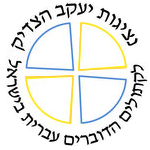First meeting of the music project “Kinor Na’im”
Benedetto reports on the gathering of musicians from the next generation in our kehillot that took place in the Monastery of Saint John in the Dersert, on Friday and Saturday, August 10 and 11, 2012.

Over the past two years, in many different conversations, the desire has arisen to invite the members of the different kehillot who deal with music to come together in order to study together the teaching of the Church with regard to this “profession” and to benefit from the experience of each one. Finally, this year, the occasion arose to make this possible and to meet together for an entire week end, praying, singing and studying together. The theme of the week end was “Music and Song in the Mass” – i.e. what are the basic rules for accompanying this central sacrament in the life of every Christian.
On Friday, towards evening, the participants arrived at the Monastery of Saint in the Desert – a wonderful ambience for this meeting – and after evening prayer, we dined together in joy, peace and with good appetite.
At 21.00, we gathered in the chapel that according to tradition marks the place of burial of Saint Elizabeth, mother of Saint John the Baptist, and there we initiated a time of getting to know one another based upon two questions: “What has Jesus done in my life?” and “what place does music have in my life?” This exchange went on for about an hour and a half.
Hearing how God has drawn each one of us was stupendous and especially moving was to strengthen our awareness that music knows how to be a privileged tool in meeting God. Each story revealed a unique path, a path that led us to meet and share on this very evening.
On Saturday morning, two other participants from the Haifa kehilla joined us and we began the workshop in earnest, after the previous day had established the right atmosphere. At 9.30, Father Rafic gave a talk focused on the parts of the mass, a talk that was clear and enunciated the logic of the structure of the mass in its present form as we participate in it and in the light of what the Church teaches about it. In this context he also stressed the importance of music in the liturgy, in general terms and in particular details.
The morning continued with the exchange of songs among the participants. Each one brought a few songs and taught them to the group. We managed to learn three versions of the Sanctus: one traditional and two new versions, as well as a few communion songs. It is indeed very surprising to realize the quality of creativity in our kehillot right now: in almost each kehilla there are members who are composing new songs or translating beautiful songs into Hebrew – a great treasury which are committed to preserving as best we can.
Towards noon, I then spoke about another important theme: directing the singing during mass. More than a lecture, this was a series of comments about the role of the music director, very sensitive, because it is within his capacity to bring the assembly into the heart of the prayer or to interfere with this. I intended to emphasize some specific points about the role of the music director, for example that s/he must be completely present and at the same time look towards the future. The one who is responsible directs the singing in the assembly and his heart is already preparing the next song. S/He is racing forward but also taking the assembly into consideration thinking about which song they can sing. Sometimes it is s/he who must back down even if it is not musically correct. The important principle in liturgy is: to be together.
Another important aspect is flexibility. It is desirable that everything be prepared and organized during the rehearsals before the prayer, however there is always the need to leave the door open to sudden surprises that happen in every human activity. The director must be very sensitive to the spirit of the prayer and to discern whether it might be necessary, for example, to introduce small changes into what has been decided.
Very important is to remember that the music director has no other possibility to pray than in the singing itself. The song and the music is his/her prayer. Helping the community to prayer constitutes his or her prayer. The musical instrument that he or she plays is an additional member of his or her body. The music director cannot pray like everyone else. S/He cannot sink into the depths of prayer completely but rather has to stay awake and present in the liturgy. Despite this, s/he has the right to pray too.
His or her heart turns to the heights, but the soul and mind are awake and ready to act. In order that s/he be ready to act when it becomes necessary, it is recommended that his look be ready to accommodate at every moment hints from the chief celebrant. This communication (non verbal as it is) is one of the important constituents of praying together.
By means of the study and discussion we discovered afresh how beautiful and how challenging it is to deal with music and liturgy, a mission not given to everyone, a service of the Church and God’s glory.
After lunch, we prepared the songs for the mass that we celebrated in the Jaffa kehilla. The kehilla received us in joy and with a warm heart as always.
From this weekend, a sweet taste remains of a Church experience that was very significant and the desire to continue in this sacred work for ourselves and for the holy Church.












 Meeting of Priests in Tiberias
Meeting of Priests in Tiberias Interview with Fr. Benny for Magdala YouTube Channel
Interview with Fr. Benny for Magdala YouTube Channel Farewell of Monika Faes in Austria
Farewell of Monika Faes in Austria Lent Retreat 2024
Lent Retreat 2024 Lent Walk with the Cross
Lent Walk with the Cross Booklet for Lent 2024
Booklet for Lent 2024 Priests of St. James Pray in Bethlehem
Priests of St. James Pray in Bethlehem